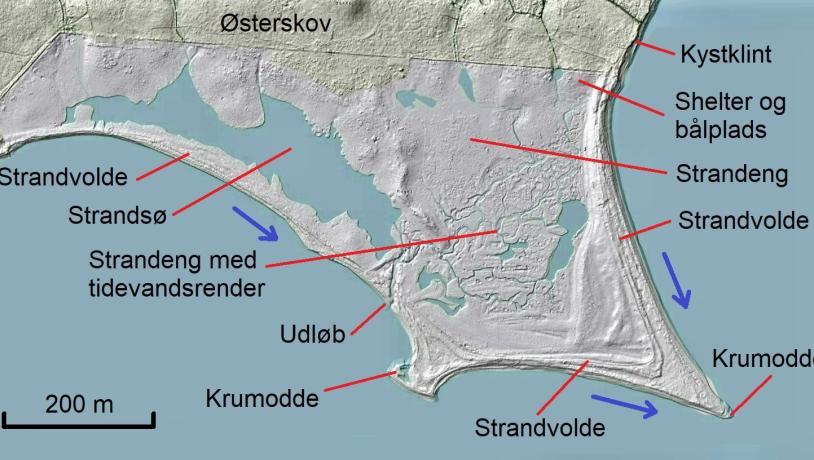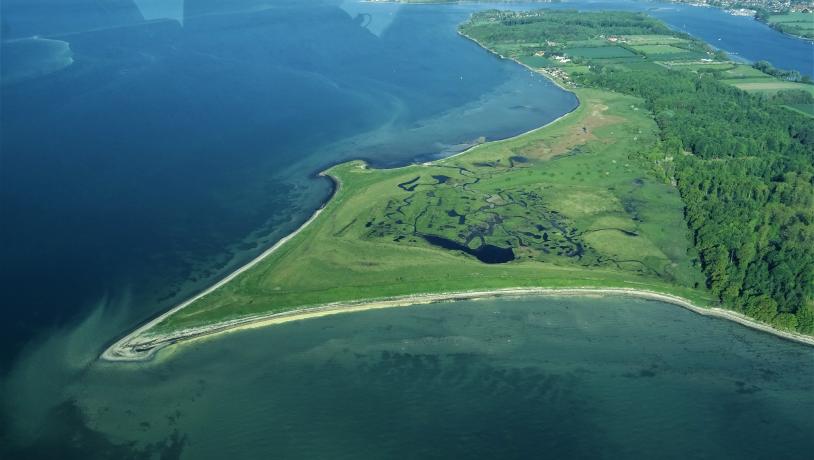Thurø Østerskov og Thurø Rev (Thurø Eastern Forest and Thurø Reef)
Coastal cliffs with deposits from two ice ages, as well as a well-developed Holocene angle foreland with rich plant- and bird life and good swimming opportunities.
Thurø Østerskov and Thurø Rev are located on the southeasternmost part of the island of Thurø. Towards the coast, Østerskov ends in a low but steep coastal cliff, where you can see moraine clay from two different ice ages. Just south of this is one of Svendborg Municipality's finest salt marshes, Thurø Rev, a flat and desolate landscape created by the sea.
Both sights are easily accessible from the beach next to Thurø Campingsite and from the parking lot in Østerskov. Thurø Rev is a popular recreational area and in addition to beachgoers in the summer months, it is popular with hikers, birdwatchers and anglers. The beach is of varying quality. Close to the water's edge, at the southern edge of Østerskov forest, there is a shelter and campfire site.
Thurø Rev was previously owned by farmers and crofters who used the meadows for summer grazing of cattle. Today, the area is owned by the Danish Nature Agency and is still grazed, but now as part of the nature management necessary to preserve the open landscape. If this cultural impact ceases, the salt meadow will quickly overgrow with reeds, grasses and the special vegetation, and many animal species will disappear.
Thurø Reef is a botanist's paradise with many rare plants adapted to the special environment. In May, large areas are covered by a beautiful pink carpet of flowering English grass. During the winter months and during storms and high tides, the salt marshes are sometimes flooded by the sea, so the hardy plants that grow here are naturally saltwater tolerant. The many tufts in the grassland areas are due to the yellow meadow ant.
The inner parts of Thurø Rev are fenced off, partly to protect the grazing animals and partly to mark the boundaries of the area, which is home to many bird species. Especially the wet depressions in the salt marshes are an ideal habitat for many wading birds.
For the same reason, you should not move within the enclosure during the birds' breeding period from March 15 to July 1. Thurø Reef is also a resting place for many migratory birds.

Photo:Kort: GeoFyn. Illustration: Søren Skibsted.
The ice age landscape at Thurø Østerskov
Thurø Østerskov spreads over an even or slightly undulating moraine surface without significant differences in elevation. The surface consists of fairly fat moraine clay, which means that the groundwater is high and that the forest floor and the path south of the parking lot are often muddy in the winter months and during periods of heavy rainfall.
Towards the coast, erosion by the sea has created an 850 m long and 5.5 m high cliff, showing a cross-section through the upper part of the moraine surface. The layers lie neatly on top of each other and, as one of the relatively few places in the archipelago, have not been folded or otherwise disturbed during glacial overruns.
At the bottom of the cliff is blue-gray moraine clay with scattered stones. This layer can also be seen at the bottom of the cliff at Smørmosen, 1.3 km further north. It possibly dates from the younger part of the 'third-last ice age', the Elster Ice Age (480-424,000 years before present), where it was deposited by an ice advance from the Baltic Sea regions.
Separated by a fairly sharp boundary, above it lies a thick layer of brownish moraine clay, deposited by one of the last ice advances of the last ice age, the Weichselian - possibly by the part of the Bælthav Ice Stream known as the 'Great Belt Glacier' (18-17,000 years before present). This moraine deposit forms the surface layer of most of Thurø.
Thus, about 410,000 years of deposits seem to be missing between the blue-gray and brown moraine clay. They have apparently been eroded away by glaciers during the last two ice ages.
On the beach next to the cliff, you can find different types of stones, including many articulated blocks. These are stones that can be identified by location. Many of them were brought here by ice streams from southern Sweden and the Baltic Sea area.
The dynamic coastal landscape
Since the sea in the Holocene (the period after the last ice age) invaded the area south of Funen and created the South Funen Archipelago, Thurø's glacial landscape has been gnawed away. The loosened clay, sand and gravel is carried by coastal currents to places where the material can be deposited and create new land - marine foreland.
The distinctive landscape of Thurø Rev is a so-called angular foreland - a marine foreland that forms a roughly triangular shape from the coast. This can occur in several ways, such as here at the 'corner' of Thurø, where coast-parallel ocean currents have brought in material from two different directions - from the west along the south coast and from the north along the east coast.
The materials are deposited where the coastal currents meet, creating rows of sandy and rocky sea walls, one on top of the other. Protected by the sea walls, the central part of the area has developed into a large salt marsh area consisting of a mosaic of dry grassland and wet salt marsh with numerous small beach lakes and a network of winding tidal channels (loes). During the summer months, seawater can sometimes be trapped in drainless depressions, whose surface is slowly covered by a white crust of salt as the seawater evaporates. These depressions are therefore called salt pans.
At the tip of Thurø Reef, small curvilinear formations of sand are often seen. Which way they curve depends on the current wind, wave and current conditions. The Thurø Reef itself continues another kilometer out to sea as an underwater sand and stone reef with mussel beds.
Scattered on the surface of the marine foreland are a number of large stones that the sea has washed out of the ice age deposits that form the 'foundation' under Thurø Rev.

Photo:Søren Skibsted
The landscape in the future
From a geological perspective, the glacial landscape in and around Østerskov is unlikely to change in the foreseeable future. However, increased precipitation will affect the groundwater level and runoff conditions on the clayey moraine surface and locally raise the water level in local depressions, which is detrimental to cultivation areas with low-lying soils and low-lying properties.
This also applies to the areas currently covered by Østerskov, where soil conditions can change due to, for example, temporary water damming and the formation of so-called pseudo-gley in the upper soil horizons. In the long term, this will affect the choice of tree species in future forestry.
The majority of the moraine landscape is covered with vegetation and/or cultivated, which, together with the clay surface layers and very limited terrain slopes, is unlikely to lead to significant changes in surface erosion, even with an increasing frequency of cloudbursts.
The main landscape changes for the area and the site as a whole are related to climate change, with particular regard to rising sea levels, changes in wind strengths, dominant wind directions and the nature of coastal currents, as well as in erosion and deposition patterns. With rising sea levels, increased erosion of the nearby coastal cliffs is to be expected, but under the right conditions, it can also lead to increased sediment supply towards the coast. How these conditions will develop is not known with certainty.
Thurø once formed two parallel islands, separated by a narrow strait through the low-lying area of Smørmosen. A water level rise of 1.7 m and above will restore this condition. If the water rises to over 3.1 m above the daily water level, a further narrow north-south strait will form through the western part of Østerskov, turning southeastern Thurø into a small independent island.
Even with a water rise of 1 m, the central salt marshes on Thurø Rev will be submerged and in a storm surge or high water situation accompanied by a strong backwater around the island, the entire Thurø Rev will be flooded.
Value
The coastal cliff's deposits of moraine clay - especially the lower, blue-gray, (possible) Elster moraine - add important pieces to the puzzle of the area's glacial development history. Together with the coastal cliff at Smørmosen, the Østerskov cliff is one of the few selected sites within the Geopark that apparently has a low degree of glacial tectonic deformation, i.e. disturbances of the layers caused by moving glaciers.
Thurø Reef is protected under EU Natura 2000 site no. 242 and Habitat area H242 and hosts different biotopes with a wide variety of interesting plant communities. It is also an important habitat for wading birds and a resting place for migratory birds.
Thurø Østerskov and Thurø Reef has recently been classified as a Site of Regional Geological Interest (RGI).
Longitude: 10.714502
Latitude: 55.034663